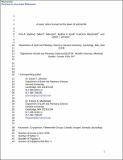| dc.contributor.author | Sperling, Erik A. | |
| dc.contributor.author | Halverson, Galen P. | |
| dc.contributor.author | Knoll, Andrew Herbert | |
| dc.contributor.author | Macdonald, Francis Alexander | |
| dc.contributor.author | Johnston, David T | |
| dc.date.accessioned | 2014-06-18T15:59:27Z | |
| dc.date.issued | 2013 | |
| dc.identifier.citation | Sperling, Erik A., Galen P. Halverson, Andrew H. Knoll, Francis A. Macdonald, and David T. Johnston. 2013. A Basin Redox Transect at the Dawn of Animal Life. Earth and Planetary Science Letters 371-372: 143–155. | en_US |
| dc.identifier.issn | 0012-821X | en_US |
| dc.identifier.uri | http://nrs.harvard.edu/urn-3:HUL.InstRepos:12334297 | |
| dc.description.abstract | Multiple eukaryotic clades make their first appearance in the fossil record between ~810 and 715 Ma. Molecular clock studies suggest that the origin of animal multicellularity may have been part of this broader eukaryotic radiation. Animals require oxygen to fuel their metabolism, and low oxygen levels have been hypothesized to account for the temporal lag between metazoan origins and the Cambrian radiation of large, ecologically diverse animals. Here, paleoredox conditions were investigated in the Fifteenmile Group, Ogilvie Mountains, Yukon, Canada, which hosts an 811 Ma ash horizon and spans the temporal window that captures the inferred origin and early evolution of animals. Iron-based redox proxies, redox-sensitive trace elements, organic carbon percentages and pyrite sulfur isotopes were analyzed in seven stratigraphic sections along two parallel basin transects. These data suggest that for this basin, oxygenated shelf waters overlay generally anoxic deeper waters. The anoxic water column was dominantly ferruginous, but brief periods of euxinia likely occurred. These oscillations coincide with changes in total organic carbon, suggesting euxinia was primarily driven by increased organic carbon loading. Overall, these data are consistent with proposed quantitative constraints on Proterozoic atmospheric oxygen being greater than 1% of modern levels, but less than present levels. Comparing these oxygen levels against the likely oxygen requirements of the earliest animals, both theoretical considerations and the ecology of modern oxygen-deficient settings suggest that the inferred oxygen levels in the mixed layer would not have been prohibitive to the presence of sponges, eumetazoans or bilaterians. Thus the evolution of the earliest animals was probably not limited by the low absolute oxygen levels that may have characterized Neoproterozoic oceans, although these inferred levels would constrain animals to very small sizes and low metabolic rates. | en_US |
| dc.description.sponsorship | Earth and Planetary Sciences | en_US |
| dc.description.sponsorship | Organismic and Evolutionary Biology | en_US |
| dc.language.iso | en_US | en_US |
| dc.publisher | Elsevier BV | en_US |
| dc.relation.isversionof | doi:10.1016/j.epsl.2013.04.003 | en_US |
| dash.license | OAP | |
| dc.subject | Cryogenian | en_US |
| dc.subject | Fifteenmile Group | en_US |
| dc.subject | Canada | en_US |
| dc.subject | oxygen | en_US |
| dc.subject | animals | en_US |
| dc.subject | physiology | en_US |
| dc.title | A Basin Redox Transect at the Dawn of Animal Life | en_US |
| dc.type | Journal Article | en_US |
| dc.description.version | Accepted Manuscript | en_US |
| dc.relation.journal | Earth and Planetary Science Letters | en_US |
| dash.depositing.author | Knoll, Andrew Herbert | |
| dc.date.available | 2014-06-18T15:59:27Z | |
| dc.identifier.doi | 10.1016/j.epsl.2013.04.003 | * |
| dash.contributor.affiliated | Sperling, Erik A. | |
| dash.contributor.affiliated | Macdonald, Francis | |
| dash.contributor.affiliated | Knoll, Andrew | |
| dash.contributor.affiliated | Johnston, David | |


